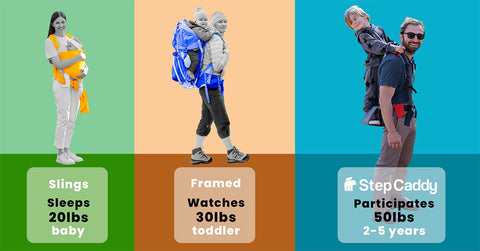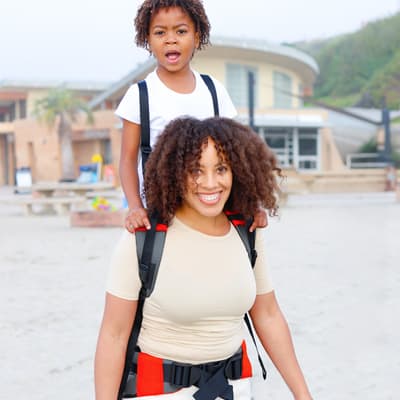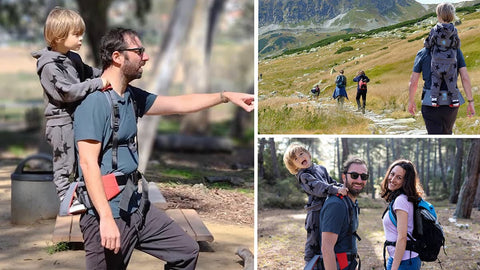

Best Hiking Carriers for 4 Year Olds
Exploring the great outdoors with your young child (aged 4 or 5) can be both an incredible opportunity to create lasting family memories and exhausting. Your preschooler is more independent, more mobile, but also much heavier. At this age, they have outgrown nearly all the child carriers on the market, but they're not ready to power through a reasonably large hike or a long day out on foot.
At some point, every parent of a preschooler faces that tired little voice mid-hike or mid-theme park, "Carry me!". While your child starts the day brimming with energy, curiosity, independence, and their adventurous spirit, their little legs can't keep up. Welcome to the preschooler paradox: your child is too big for most carriers, too young for long distances, and too independent for cumbersome strollers. But the average 4-year-old boy weighs 38 lbs (17 kg)! Carrying this much weight without the right tools leads to back pain, shoulder aches, and will quickly tire you out. No wonder parents tend to dread carrying, avoid carrying, experience stress, weather tantrums, and even postpone longer days out.
This doesn't have to be the case, with the right carrier. However, when your child is a baby, you have thousands of carriers to choose from. As a toddler, you have hundreds of options. When your child reaches preschool age (3, 4, and 5), preschool carrier options dwindle to half a dozen.
So, what now?
Let's talk strategy. Specifically, how to carry your 4-year-old in a way that's safe, comfortable, and keeps your spine intact. We will list the available carriers suitable for 4-year-olds, from framed backpacks to ergonomic marvels like the Step Caddy. We'll break down the best child carrier options and why your decision matters more than ever at this age.
Choosing a child carrier for a 4-year-old (and large 3-year-olds) is a different challenge than choosing for toddlers. The size, weight, and usage patterns have all changed, making the right choice a little more critical. Let's break down the new challenges:
- Weight: The average 4-year-old boy weighs 38 lbs (17 kg)! Carrying this much weight unsupported leads to back pain and shoulder ache. Proper support for an adult's back is vitally important as the child gets older and heavier. Look for carriers with solutions for transferring weight away from the back.
- Size: Your child isn't just heavier, they are also taller, with longer limbs. The comfort of the child and the parent can be impacted simply by the size of the child. In a seated carrier, either a traditional framed carrier or a soft-structured carrier, where do the kids' long arms and legs go? Are the arms dangling down the side, are their feet rhythmically knocking the backs of the parents' legs?
- Activity: Your 4-year-old enjoys running, exploring, and the freedom their new mobility gives them. You do not expect to be carrying them all day, all the time. Your kid needs to be carried intermittently, or to be carried for parents' peace of mind (e.g., festivals, crowded plazas, airports, etc). Hence, a child carrier that is quick and hassle-free to climb on and off is a must-have feature.
- Engagement: On a grand day out, even though your kid's legs are tired, their brain is not. Choose a hiking carrier, that enables them to continue engaging with the world and with you. Don't miss out on the amazing shared experiences and conversations when the child carrier elevates the kid's view, and does not bury it in your back.
Choosing a Hiking Carrier for 4 Year Olds
Thus, choosing the right hiking carrier for a 4-year-old is crucial. It ensures a pleasant experience for everyone involved. It can remove stress, hassle, tantrums, and back pain, and can extend a great day out. The right carrier can make all the difference. You are looking for a preschool carrier, or maybe a hiking carrier that:
- Transfers weight effectively to your hips - away from your back. Look for carriers with intentional weight transfer solutions. Look at the back posture needed when carrying - ensure the back is straight, the parent is balanced and mobile.
- Large sizes to accommodate a bigger kid - look where the legs and especially the feet go.
- Ease of use - The carrier must be quick and hassle-free to climb on and off. The easier and more seamless it is for your child to go from walking to riding, and back to walking again, the more you will use the carrier.
- Supports Engagement - Preschool-aged kids are fully engaged and participate. Their legs may be tired, but that does not mean they want to stop interacting; don't miss out on the opportunity for amazing shared experiences and conversations.
- Packs Up Small - Optional. If you are travelling or would prefer not to wear the child carrier all day, when it is not in use, look for a hiking carrier that can pack away into your day-bag, backpack, or carry-on. This is usually the winning feature of soft-structured carriers.
These Are the Top Hiking Carriers for 4 Year Olds
Below are the top hiking carriers that work for 4-year-olds. But one must still check the manufacturer's specifications carefully. For example, the Deuter Kid Comfort 3 Child Carrier specification states the maximum weight is 48.5 pounds, which at first look would comfortably accommodate your 4-year-old. But this weight specification includes the weight of the child, any gear, any snacks, and the pack. Your 4-year-old is likely close to 38 lbs already, so read and understand the manufacturer's specifications and consider how long the carrier will last you.
Below we look at:
- Deuter Kid Comfort 3: All-day hikes; travel; larger preschoolers. Adjustable, great ventilation/storage. supreme comfort.
- Osprey Poco Premium: All-day hikes; travel; larger preschoolers Adjustable, great ventilation/storage.
- My Freeloader: Designed for children 2.5 years or older with a carrying capacity of up to 80 lbs!
- Piggyback Rider Scout: Short hikes or mixed walking and riding Light weight, great ventilation, child can walk/riding mix, fun.
- The Step Caddy: All-day hikes; travel; larger preschoolers Adjustable, great ventilation, child can walk/riding mix, fun, innovative design.
1. Deuter Kid Comfort 3
Big framed carriers are the limousines of toddler carriers. They transfer weight to the hips really well through the frame. The main concerns for using with a 4-year-old is does the kid still fit comfortably in the seat, and that the child will want to get in and out, which is a big hassle. When the kid is not in the carrier you are lugging around 8'lbs of carrier on your back, it is not something you can just stow away when it's not in use.
- Ages: Up to 48 lbs (inc stowed items)
- Price: $350
- Pros:
# Weight distribution is excellent with an internal frame that channels the child's weight to a load-bearing waistbelt.
# The carrier is bulky, but ventilation is good, utilizing mesh panels around the frame to keep the wearer's back aired.
# Additional storage is excellent, with compartments for snacks and gear.
# Comfort is excellent, should be based on the name, achieved with heavily padded and adjustable straps, waistbelt, and seating for the child - Cons:
# It is bulky and heavy (~7 lbs 11oz), making portability very poor. It will consume half your car trunk space. You do not need to pack it away, because you will have to wear it all day.
# Getting in and out is involved and time-consuming.
# Balance & Mobility is concerning for a heavy 4-year-old, the sitting weight is high up the torso, and the child's center of mass is a good 12" behind the adult which will have an impact on balance and stability.
# Ergonomics for a 4 year old is medium to poor. The child is cramped in the chair.

2. Osprey Poco Premium
Osprey Poco Premium gives lots of storage, convenient extras like sunshade and day-pack. Great for parents who carry a lot of gear.
Big framed carriers transfer weight to the hips really well through the frame. The main concerns for using with a 4-year-old is does the kid still fit comfortably in the seat, and that the child will want to get in and out frequently, which is a big hassle. When the kid is not in the carrier you are lugging around 8'lbs of carrier on your back, it is not something you can just stow away when it's not in use.
- Ages: Up to 48 lbs (inc stowed items)
- Price: $420
- Pros:
# Weight distribution is excellent with an internal frame that channels the child's weight to a load-bearing waistbelt.
# The back panel uses a continuous mesh fabric wrapped around the metal frame, so the pack is slightly suspended off your back for ventilation.
# There are pockets galore. 11 pockets and a whopping 36 liters total of volume.
# Comfort is excellent, achieved with heavily padded and adjustable straps, waistbelt.
# Comes with a sunshade - Cons:
# It is bulky and heavy (~8 lbs 5.4 oz), (heavier than the Deuter) making portability very poor. It will consume half your car trunk space.
# Getting in and out is involved and time-consuming.
# Balance & Mobility is concerning for a heavy 4-year-old, the sitting weight is high up the torso, and the child's center of mass is a good 12" behind the adult which will have an impact on balance and stability.
# Ergonomics for a 4 year old is medium to poor. The child is cramped in the chair. The stirrups help with the dangling feet.

3. My Freeloader
- Ages: Up to 80 lbs
- Price: $320
- Pros:
# Weight distribution is good with an internal solid structure that distributes the child's weight evenly across the harness and load-bearing waistbelt.
# Reasonably light at 5.8 lbs. Folds in half to reduce its size.
# Comes in two sizes for adults with larger torsos.
# Good low center of mass, that is close to the adult's center of mass, for good balance and mobility.
# Ergonomically good for a 4-year-old. The child sits lower than the Deuter or Osprey, so they may be staring at your back. - Cons:
# Not super light, and does not fold up that small. Still better than many carriers like the Osprey or Deuter.
# Weight distribution is good, but could be better. Reviewers reported a sore back after 45 minutes of carrying, probably due to the inclination to lean forward when carrying.
# Additional storage pockets on the belt side are minimal compared to other carriers.
# Loading the child can be difficult. Reviewers commented that the process typically requires lifting the child into position and securing the harness behind you: “It’s a bit of a two-person job"
# Comfort for the child that is straddling a bench is limited - but good for shorter journeys. The child's legs tend to wrap around the adult and ache.
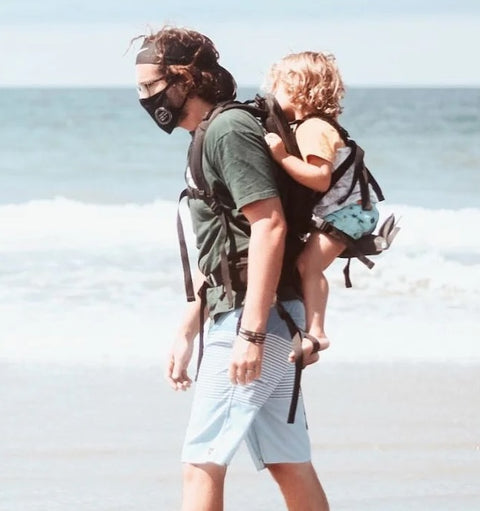
4. Piggyback Rider Scout
A smart simple child carrier that provides a standing platform (a bar), allowing children more freedom and a fun vantage point. Has very easy on-off ease-of-use, and tons of customer reviews extolling the convenience. For a 4-year-old use, the fact the weight is ALL carried on the shoulders with no weight transference to the hips is a concern for back comfort and balance on uneven ground. Packs up small, is light and is great for travel for those reasons.
- Ages: Up to 50 lbs
- Price: $150 (plus accessories)
- Pros:
# Very lightweight and packs up small. Great for packing away and taking on your day out or travels.
# Good balance and mobility. The child in a standing position places their center of mass really close to that of the adult's.
# No storage on the carrier - BUT since it is lightweight and very portable, it gets packed into a backpack, which will carry your other items.
# Comfort is good. The carrier gets great reviews for comfort, the only concern is long term comfort with all the weight going to the adult's shoulders.
# Very easy to use, with quick and easy mounting and dismounting, no additional adult assistance required.
# Ergonomically fantastic for a 4-year-old. No cramped conditions, great vista view to stay connected with the parent for shared experiences. - Cons:
# Weight distribution is poor, ALL the weight going directly to the shoulders and back of the adult.
# The child stands on a bar, there is nothing securing the feet from slipping.
# Tips of the feet and the bar, poke into the adult's back, unless the child stands with their feet far apart to go either side of the adult's back.
# Muddy feet on the bar will dirty the adult's cloths. (There is an accessory "skirt" that addresses this)
# The child is standing, so no option for sleeping if that is needed.
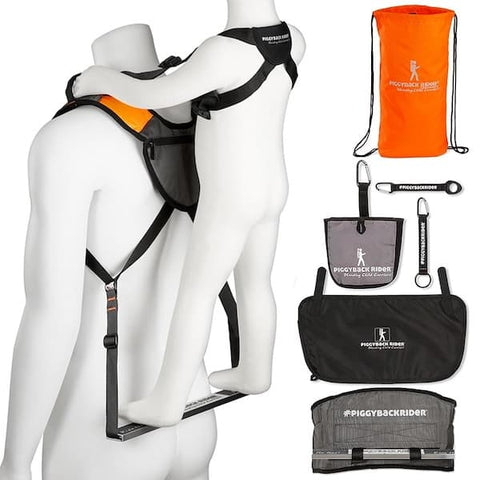
5. The Step Caddy Carrier
Step Caddy is a unique innovation that reimagines the piggyback ride into a safe, comfortable, and portable experience perfect for hiking and adventures with preschoolers. It combines comfort, versatility, and convenience into a balanced, backpack-like design. it provides a standing platform, allowing children more freedom and a fun vantage point, while significantly reducing the strain on parents.
- Ages:
2 -5 years old (50 lbs) - Price:
$195 - Pros:
# Saves Your Back: Weight distribution is unmatched. Step Caddy uses a special, patented load-bearing waistbelt that transfers allt he kids weight directly to the hips.
# Balance and Mobility is excellent, with a low center-of-mass, an even lower weight transfer point at the hips the adult's balance and mobility is maximized, even on rough terrain.
# Exceptional Ease-of-Use: The piggyback standing position creates the easiest carrier to climb-on and climb-off. Additionally, because the child's weight is all on the hips and not the torso, this makes standing up from the loading crouch much easier.
# Packs Up Small: small. Small enough to throw into your bag, trunk, or carry-on. - Cons:
Only hydration accessories options available at this time. The child is standing, so no option for sleeping if that is needed.

Comparison Summary
Age / Weight | Weight Transfer | Balance & mobility | Ergonomic Design for 4-Year-Old | Storage & Pockets | Ease of Use | Packs Up Small | |
Deuter Kid Comfort 3 | 4-year-old < 48lbs | Excellent | Good | Moderate | Good | Poor | Poor |
Osprey Poco Premium | 4-year-old < 48 lbs | Excellent | Good | Moderate | Excellent | Poor | Poor |
Freeloader | < 80 lbs! | Moderate | Excellent | Moderate | Moderate | Moderate | Moderate |
Piggyback Rider Scout | 5-year-old < 50 lbs | Poor | Moderate | Excellent | Not Applicable | Excellent | Excellent |
Step Caddy | 5-year-old < 50 lbs | Excellent | Excellent | Excellent | Not Applicable Hydration Holders | Excellent | Excellent |
How to Choose the Right Hiking Carrier for Your Family
Selecting the right hiking carrier for your family involves various considerations. The first aspect is comfort for both the parent and the child. A carrier with adjustable straps and ample padding ensures a snug fit. Next, consider your hiking habits and environments. Consider all the other potential uses and situations you will want to use the carrier - are you going traveling, to theme parks, or a festival?
Child Carriers are expensive; pick one that will accommodate all your needs.
Finally, think about additional features that we identified as important for a Hiking Carrier for a 4-Year-Old:
- Transfers Weight to your hips
Click Here: Interesting article on protecting the spine - Ergonomic for larger kids
- Ease of use
Click Here: Interesting article on Piggyback Carriers - Packs Up Small
Frequently asked questions
Most hiking carriers are suitable for children aged six months up to four years. Age, however, depends on the child's weight and carrier specifications.
The carrier must distribute weight evenly. Adjust straps for both comfort and safety. Ensure your child is snugly seated, with no excessive movement.
Yes, they are safe if used correctly. Choose carriers with certifications and safety features like a five-point harness. Regularly check for product recalls.
Absolutely! These carriers are versatile. Use them for travel, city tours, or even beach outings. They adapt to various environments and activities.
Regular cleaning and inspection are essential. Check for damage after every hike. Follow the manufacturer's guidelines for specific maintenance requirements.

